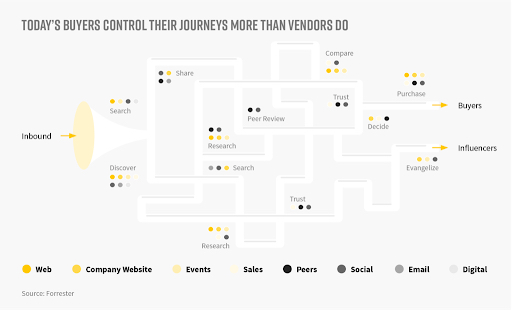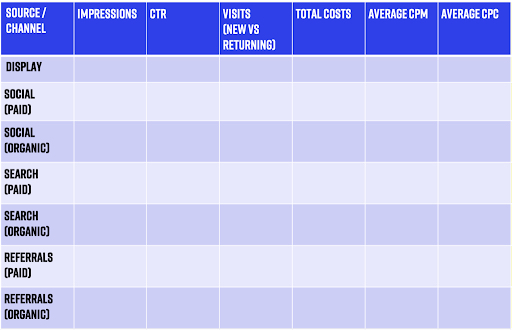Marketers need to know what they want to accomplish before they can move fast and break things. But because B2B marketers have to move at the speed of a digital-first world, that often means finding opportunities to adjust their work as they’re in the midst of it.
So what should marketers do in this scenario? Simple: optimize.
What do we mean by optimization in B2B marketing?
Why B2B marketers should optimize for the entire customer journey
Four key barriers to optimizations that marketing leaders need to remove
How B2B marketers can optimize for reach and account coverage
What do we mean by optimization in B2B marketing?

For any B2B marketer, optimization can mean a variety of things. You can optimize page speed load, keywords, content optimization, email deliverability, and much more. But all of that activity is often in service of one goal: conversion.
The idea of conversion rate optimization has been commonplace since at least the early 2000s, with Moz defining it as “the systematic process of increasing the percentage of website visitors who take a desired action.”
But while that might be fine for businesses that transact exclusively online with just one buyer, the reality of B2B marketing means such a limited approach is too narrow. A warning: “Optimization” doesn’t mean “perfection.” Do not worry about optimization at the expense of getting things out the door.
Optimization in B2B marketing should cover the entire customer experience
For many B2C marketers, a customer is a single person, who, more often than not, acts alone.
Things are more difficult for B2B marketers. As customers are businesses or organizations with multiple employees, there are often multiple people that must be marketed to — a critical factor contributing to the rise of modern account-based marketing.
According to Gartner, the typical buying group for B2B tools usually involves six to 10 decision-makers. Naturally, decision-making is taking longer.
As such, the typical way B2B marketers measure performance — marketing-qualified leads — isn’t enough to drive predictable revenue. A simple whitepaper download or handover to sales cannot be the endpoint of conversion.
Putting the customer first and optimizing the outcome of such a process needs a wider view and should not be structured around siloes of customer success, sales and marketing.
Instead, optimizing for the customer experience should start with understanding how each stakeholder within a target account experiences your brand. Then, ideally, you can work back through their journey to find out where improvements can be made.
Why is optimization critical to long-term success?
At a simple level, optimization can help provide any marketer with some easy wins. By identifying key points in the buyer journey and making the process simpler, easier, and of higher quality, the marketing department can increase its contribution to the bottom line.
But there’s also a bigger picture at play. The reality is that the length of time for which companies can enjoy success is shrinking. Analysis by Innosight has found that the average tenure for companies on the S&P 500 is forecasted to shrink from 30 to 25 years to 15 to 20 in this decade. Companies must change if they want to stay competitive.
It’s also not just companies that need to change. Individual marketers must optimize their skills to maintain employability in an increasingly tough environment. By bringing optimization into their work, they can demonstrate continued results even as competitors up the challenge.
In the short term, optimization is also important as key factors can change rapidly. Targets go up simultaneously as the costs of acquiring new customers rise. Meanwhile, potential buyers disengage after being deluged with poor-quality marketing and sales outreach efforts.
The marginal gains of optimization add up
However, there is good news even among the challenges that B2B marketers are facing. Continually adding small gains adds up over time to an improved experience throughout the buyer journey — whether at the qualification stage, during an interaction with the sales team, or even as they consider renewing or upgrading.
Why B2B Marketers Should Optimize for the Entire Customer Journey

While those selling to consumers often only have to deal with a single individual and can manage almost their whole experience through the website, B2B marketers have to contend with multiple people in a buying unit, lengthier and more complex sales cycles, and the fact that departments other than marketing also have a say in maintaining and retaining a B2B customer.
Also, remember that buyers and buying teams do not take linear paths. Instead, they choose their journeys by interacting with a mixture of self-service content and conversations with people, as illustrated in the image below from The Engagement Imperative.

Customers and prospects don’t care about singular points and events
In marketing, a performance measurement is often a single event or trigger. For example, when a lead form is completed or a prospect passes a lead score threshold, they qualify for sales.
It might be tempting for marketers to look at optimization in terms of only their targets, like the number of MQLs generated or the total value of marketing-sourced pipeline. However, buyers don’t see their process as defined by your company’s processes or departmental siloes.
B2B marketers looking to make a real impact must approach optimization from the customer’s perspective. This means you must consider each part of the customer journey and determine how to improve it — even if that stage lies outside the marketing department.
You, your team and your colleagues must have an optimization mindset to make this work. If marketing is supposed to ‘own’ the customer experience, their responsibility cannot simply end when there is a handover to sales.
The whole customer journey has value
Retention is almost always far cheaper than acquisition, and because existing customers make the best advocates, any optimization approach should look across the entirety of the customer journey.
A three-stage approach to the customer journey
So how can B2B marketers tackle this complexity without inducing too much confusion? Your organization may already have customer journey maps that break down each stage. In this case, that framework may provide a good start for optimization.
If you don’t have buyer journeys already mapped out, we recommend dividing the journey up into three stages for the purposes of optimization:
Stage 1: Acquisition
This part of the customer journey is the one traditionally associated with marketing. Questions to ask as part of your optimization efforts include:
-
- What can we increase our reach across our total addressable market?
- What can we increase coverage within target accounts?
- What does our keyword research tell us about optimization targets?
- How can we optimize our on-page conversion rates for landing pages and lead forms?
- How can we optimize the research stage of the customer journey to encourage more content downloads and consumption?
- How can we engage during webinars and other events to qualify prospects for sales?
Stage 2: Engagement and Conversion
This stage of the customer journey is typically owned by both marketing and sales, with the latter taking more control as the sales process progresses. Questions to ask here for your customer engagement marketing include:
-
- How can we automate the handover from marketing to direct sales content?
- How can we optimize the self-serve experience even as prospects speak with sales colleagues?
- How can we optimize the interaction between salespeople and prospects?
- How can we optimize the sales experience through content and collateral?
Stage 3: Retention and Loyalty
This stage of the customer journey comes after purchase. In many companies, the salesperson responsible for closing the deal then hands off to customer success or an account manager. Optimization questions to ask here include:
-
- How can we optimize the onboarding experience?
- How can we optimize how customers educate themselves and find out more about the product or service?
- How can we optimize engagement for existing customers?
- How can we optimize customer advocacy?
Four key barriers that marketing leaders need to remove

1. Siloed incentives and targets
The standard revenue model for B2B organizations typically divides up targets based on the various stages of the customer journey.
One of the most common metrics marketing is measured by is the humble MQL. Sales development teams, likewise, may be responsible for new opportunities or meetings booked, while more senior sales team members are measured on the number and value of closed deals. Customer success teams might then focus on renewal volume and value.
These are all worthwhile metrics to optimize for. However, without joint incentives, each team might work separately to game the figures they are responsible for in a given month, quarter or year.
Marketing might chase MQLs that are unlikely to result in sales; sales development team members might book meetings that aren’t qualified; salespeople looking for a bonus might ignore a swathe of opportunities in pursuit of deals they can close quickly before the month-end; customer success teams only reach out a few weeks before renewal. Put together, this can lead to a disconnected experience, which ill-thought-through attempts at optimization might actually exacerbate.
That’s why B2B marketing leaders need to get buy-in and joint ownership for shared objectives from the very top.
2. Poor relationships with sales and customer success teams
Siloed incentives and targets are often both caused by and a cause of ineffective relationships between teams responsible for revenue.
The first step is to build a coalition of people to help drive change in different departments. Look to identify colleagues in different teams open to optimizing the whole customer journey and can evangelize on your behalf in their teams.
3. Disconnected data and ineffective technology
Disconnected data also acts as a barrier to optimizing the customer journey. You need to know which early efforts connected and how it had an impact on the customer — from deals closed to renewal won — to develop a holistic optimization approach.
But, even if data on each customer touchpoint is captured, you must ensure your tech stack is in order. If your marketing automation tools and CRM do not talk with each other, then identifying optimization opportunities can become tedious or, worse, harmful.
Overhauling a technology stack can be a daunting process. Instead, marketing leaders should:
-
- Look for areas that can bring rapid improvement
- Identify data fields that can be included within CRM systems
- Highlight sales opportunity stages and values that can be passed back to marketing automation platforms
4. A lack of accurate customer insights
Even if you have shared targets, great relationships and a marketing technology stack that captures every possible data point, it’s still possible that the customer intelligence you have is limited, or captured only in the heads of those with direct contact with them.
Speak to both customers and prospects — even the ones who don’t buy. Set up webinars, surveys, phone calls, interviews, or even just a meeting for coffee can help to identify which parts of the customer journey need more work.
How B2B Marketers Can Optimize For Reach and Account Coverage

There is a lot for a marketer to consider. High on the list, though, has to be how effective their reach to target customers and accounts is. Are buyers being driven to the right B2B website? Is your B2B SEO strategy in order? What about page rankings? What about outreach? For example, is your email marketing strategy effective? What about paid search? ABM?
As we said: it’s a lot. Here are a few things to consider when optimizing reach and account coverage.
Clearly define your target customer
Optimizing reach in terms of “more impressions” or “more website visitors”’ isn’t helpful. Instead, think about how you can optimize for things like “engagement time with a prospect cohort” or “content touchpoints in the customer journey.”
Don’t get us wrong: measuring impressions and visitors to your website through tools like Google Analytics can help. But you must keep your optimization goals narrowly focused on your ideal customer
Take the information from your buyer personas used in planning. Job titles, industries, headcount, geographies, and technologies used can help determine how to optimize your campaigns. Target account lists can also be helpful.
From a campaign perspective, examine that you have a clear idea of what your target prospects are researching. External and internal data sources can be valuable and ensure your view on their needs aligns with what the data demonstrates.
Get a clearer picture of your audience
The prospects and customers in your database have already been reached. Remove these contacts from the equation if you are optimizing for reach. If you pay to send early-stage messages to your existing clients or prospects already in nurture, you’ll waste money and damage your customer experience.
Organizing who you already know against who you don’t is also an opportune time to see when your last data cleansing efforts have occurred. Doing so allows you to get a more accurate view of whether these contacts can already be considered ‘reached’ or if they need to be removed.
Assess your current reach across channels
A cross-channel analysis can help you better understand how effectively each channel drives reach. Such an effort might look like the table below.

This will help you get a fast view on:
-
- Where are we driving the most impressions?
- Where are we most efficient at driving impressions?
- What is actually driving clicks and visits? And at what cost?
You’ll likely want to dig further into each channel to look at the individual campaigns you are running, but this high-level view will help you understand where to focus your efforts.
Identify what to optimize
Use your high-level view of your reach to identify priorities within your optimization efforts. Take some time here to research and compare your performance against industry benchmarks.
You may also want to ask some questions like:
-
- Are you paying more than average for your impressions?
- Is your clickthrough rate sub-par?
- Is your reach through organic channels below where you would like it to be?
- Do you need to work on your search engine optimization strategy?
- Is social media a good investment for your company?
- Are you paying unnecessarily for visits for known prospects or customers?
With these questions answered, choose where you will first focus on optimization.
Set a goal to optimize against – and consider deduping against known contacts
With your optimization priorities in hand, you can now set a goal for your reach optimization efforts. Make sure that any goal is SMART – specific, measurable, achievable, realistic and time-bound.
And as you run your campaigns, consider adding any existing contacts to an exclusion list for your paid efforts. This will help you save money, focus on reaching new prospects, and keep the customer experience high.


